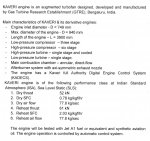Guys let us please stop these questions forever. Kaveri is flat rated and a variable cycle engine. Do you know what flat rating means and why limit of 52KN dry? This means at no altitude, temp and pressure conditions will the engine exceed this limit. However when there are differences to the ISA values, the engine will increase the airflow to sustain a minimum dry thrust of 52KN. You can expect Kaveri to give same level of thrust from seal level to about 15k feet altitude in ISA conditions. And no military engine fitted in any fighter till date has this performance level.





